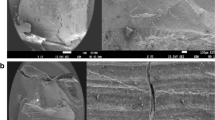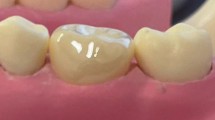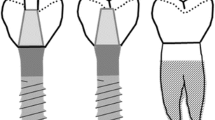Abstract
Objectives
The objective of this in vitro study was to assess the effect of wall thickness on the fracture loads of monolithic lithium disilicate molar crowns.
Material and methods
Forty-eight extracted molars were prepared by use of a standardized preparation design. Lithium disilicate crowns (e.max CAD, Ivoclar/Vivadent, Schaan, Liechtenstein) of different wall thicknesses (d = 0.5, 1.0, and 1.5 mm; n = 16 for each series) were then constructed and milled (Cerec MC-XL, Sirona, Bensheim, Germany). After placement of the teeth in acrylic blocks (Technovit, Heraeus Kulzer, Hanau, Germany), the crowns were adhesively luted (Multilink, Ivoclar Vivadent). In each series, eight crowns were loaded without artificial aging whereas another eight crowns underwent thermocycling (10,000 cycles, THE-1100, SD Mechatronik) and chewing simulation (1.2 million cycles, Willytec CS3, SD Mechatronik, F max = 108 N). All specimens were loaded until fracture on one cusp with a tilt of 30° to the tooth axis in a universal testing machine (Z005, Zwick/Roell). Statistical assessment was performed by use of SPSS 19.0.
Results
Crowns with d = 1.0 and 1.5 mm wall thickness did not crack during artificial aging whereas two of the crowns with d = 0.5 mm wall thickness did. The loads to failure (F u) of the crowns without aging (with aging) were 470.2 ± 80.3 N (369.2 ± 117.8 N) for d = 0.5 mm, 801.4 ± 123.1 N (889.1 ± 154.6 N) for d = 1.0 mm, and 1107.6 ± 131.3 N (980.8 ± 115.3 N) for d = 1.5 mm. For aged crowns with d = 0.5 mm wall thickness, load to failure was significantly lower than for the others. However, differences between crowns with d = 1.0 mm and d = 1.5 mm wall thickness were not significant.
Conclusions
Fracture loads for posterior lithium disilicate crowns with 0.5 mm wall thickness were too low (F u < 500 N) to guarantee a low complication rate in vivo, whereas all crowns with 1.0 and 1.5 mm wall thicknesses showed appropriate fracture resistances F u > 600 N.
Clinical relevance
The wall thickness of posterior lithium disilicate crowns might be reduced to 1 mm, thus reducing the invasiveness of the preparation, which is essential for young patients.





Similar content being viewed by others
References
Chan C, Weber H (1986) Plaque retention on teeth restored with full-ceramic crowns: a comparative study. J Prosthet Dent 56:666–671
Anusavice KJ (1992) Degradability of dental ceramics. Adv Dent Res 6:82–89
Sailer I, Feher A, Filser F, Gauckler LJ, Luthy H, Hammerle CH (2007) Five-year clinical results of zirconia frameworks for posterior fixed partial dentures. Int J Prosthodont 20:383–388
Della Bona A, Kelly JR (2008) The clinical success of all-ceramic restorations. J Am Dent Assoc 139(Suppl):8S–13S
Guess PC, Kulis A, Witkowski S, Wolkewitz M, Zhang Y, Strub JR (2008) Shear bond strengths between different zirconia cores and veneering ceramics and their susceptibility to thermocycling. Dent Mater 24:1556–1567
Zahran M, El-Mowafy O, Tam L, Watson PA, Finer Y (2008) Fracture strength and fatigue resistance of all-ceramic molar crowns manufactured with CAD/CAM technology. J Prosthodont 17:370–377
Zimmer D, Gerds T, Strub JR (2004) Survival rate of IPS-Empress 2 all-ceramic crowns and bridges: three year's results. Schweiz Monatsschr Zahnmed 114:115–119
Taskonak B, Sertgoz A (2006) Two-year clinical evaluation of lithia-disilicate-based all-ceramic crowns and fixed partial dentures. Dent Mater 22:1008–1013
Guess PC, Zavanelli RA, Silva NR, Bonfante EA, Coelho PG, Thompson VP (2010) Monolithic CAD/CAM lithium disilicate versus veneered Y-TZP crowns: comparison of failure modes and reliability after fatigue. Int J Prosthodont 23:434–442
Albakry M, Guazzato M, Swain MV (2003) Biaxial flexural strength, elastic moduli, and x-ray diffraction characterization of three pressable all-ceramic materials. J Prosthet Dent 89:374–380
Edelhoff D, Sorensen JA (2002) Tooth structure removal associated with various preparation designs for posterior teeth. Int J Periodontics Restor Dent 22:241–249
Kern M, Sasse M, Wolfart S (2012) Ten-year outcome of three-unit fixed dental prostheses made from monolithic lithium disilicate ceramic. J Am Dent Assoc 143:234–240
D'Arcy BL, Omer OE, Byrne DA, Quinn F (2009) The reproducibility and accuracy of internal fit of Cerec 3D CAD/CAM all ceramic crowns. Eur J Prosthodont Restor Dent 17:73–77
Reich S, Schierz O (2012) Chair-side generated posterior lithium disilicate crowns after 4 years. Clin Oral Investig. doi:10.1007/s00784-012-0868-0
Marquardt P, Strub JR (2006) Survival rates of IPS empress 2 all-ceramic crowns and fixed partial dentures: results of a 5-year prospective clinical study. Quintessence Int 37:253–259
Rosentritt M, Plein T, Kolbeck C, Behr M, Handel G (2000) In vitro fracture force and marginal adaptation of ceramic crowns fixed on natural and artificial teeth. Int J Prosthodont 13:387–391
Schmitter M, Mueller D, Rues S (2012) Chipping behaviour of all-ceramic crowns with zirconia framework and CAD/CAM manufactured veneer. J Dent 40:154–162
Attia A, Abdelaziz KM, Freitag S, Kern M (2006) Fracture load of composite resin and feldspathic all-ceramic CAD/CAM crowns. J Prosthet Dent 95:117–123
Borges GA, Caldas D, Taskonak B, Yan J, Sobrinho LC, de Oliveira WJ (2009) Fracture loads of all-ceramic crowns under wet and dry fatigue conditions. J Prosthodont 18:649–655
Silva NR, Bonfante EA, Zavanelli RA, Thompson VP, Ferencz JL, Coelho PG (2010) Reliability of metalloceramic and zirconia-based ceramic crowns. J Dent Res 89:1051–1056
Silva NR, Bonfante EA, Martins LM, Valverde GB, Thompson VP, Ferencz JL, Coelho PG (2011) Reliability of reduced-thickness and thinly veneered lithium disilicate crowns. J Dent Res 91:305–310
Lawn BR, Deng Y, Lloyd IK, Janal MN, Rekow ED, Thompson VP (2002) Materials design of ceramic-based layer structures for crowns. J Dent Res 81:433–438
Helkimo E, Carlsson GE, Helkimo M (1977) Bite force and state of dentition. Acta Odontol Scand 35:297–303
Sonnenburg M, Fethke K, Riedel S, Voelker H (1978) The load carrying capacity of the teeth of the human jaw. Zahn Mund Kieferheilkd Zentralbl 66:125–132
Abu Alhaija ES, Al Zo'ubi IA, Al Rousan ME, Hammad MM (2010) Maximum occlusal bite forces in Jordanian individuals with different dentofacial vertical skeletal patterns. Eur J Orthod 32:71–77
Varga S, Spalj S, Lapter Varga M, Anic Milosevic S, Mestrovic S, Slaj M (2011) Maximum voluntary molar bite force in subjects with normal occlusion. Eur J Orthod 33:427–433
Lee KB, Park CW, Kim KH, Kwon TY (2008) Marginal and internal fit of all-ceramic crowns fabricated with two different CAD/CAM systems. Dent Mater J 27:422–426
Titley KC, Chernecky R, Rossouw PE, Kulkarni GV (1998) The effect of various storage methods and media on shear-bond strengths of dental composite resin to bovine dentine. Arch Oral Biol 43:305–311
Coelho PG, Bonfante EA, Silva NR, Rekow ED, Thompson VP (2009) Laboratory simulation of Y-TZP all-ceramic crown clinical failures. J Dent Res 88:382–386
Conflict of interest
The authors declare they have no conflict of interest.
Author information
Authors and Affiliations
Corresponding author
Rights and permissions
About this article
Cite this article
Seydler, B., Rues, S., Müller, D. et al. In vitro fracture load of monolithic lithium disilicate ceramic molar crowns with different wall thicknesses. Clin Oral Invest 18, 1165–1171 (2014). https://doi.org/10.1007/s00784-013-1062-8
Received:
Accepted:
Published:
Issue Date:
DOI: https://doi.org/10.1007/s00784-013-1062-8




